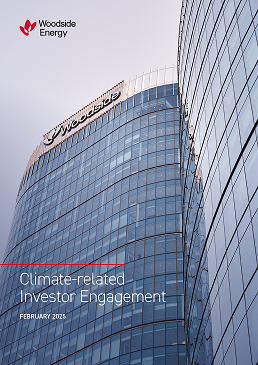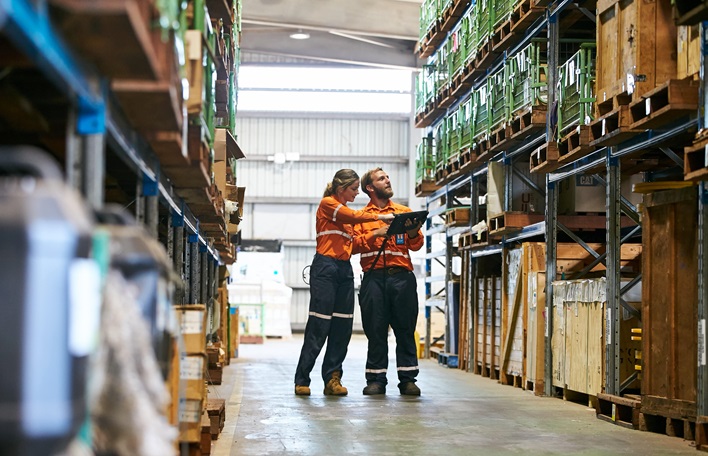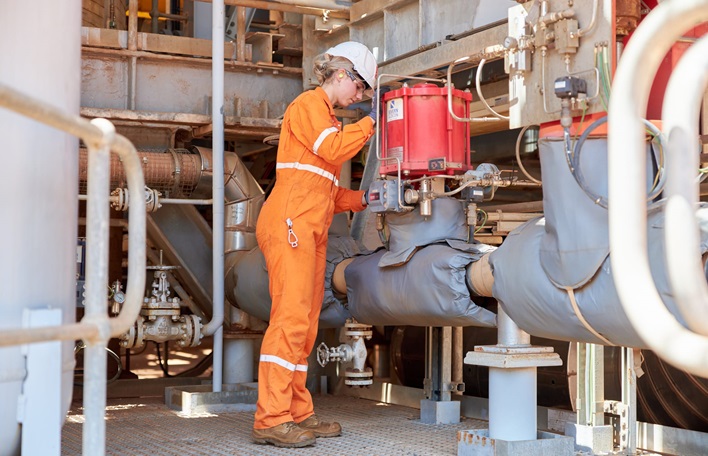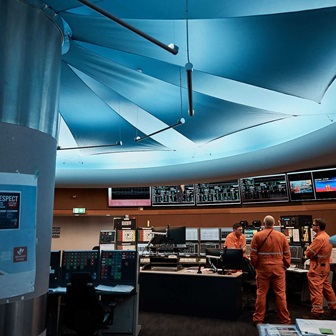
Climate governance
Climate governance
Information relevant to Woodside’s climate governance is available on the Sustainability governance page and Corporate governance and policies page. Additional information is also contained with the 2024 Annual Report.
Investor engagement
The Climate-related Investor Engagement document describes how Woodside conducts engagements with investors and the themes raised. It highlights the continuing development of our climate strategy over time and how this is informed by our investor engagements.

Disclosures
Task Force on Climate-Related Financial Disclosures (TCFD)
The following table provides an index of our various 2024 climate-related disclosures utilising the four pillars described in AASB S2, a mandatory climate-related financial disclosure standard from 1 January 2025.1
AASB S2 is built on the same pillars as the now disbanded TCFD. The International Financial Reporting Standard (IFRS) Foundation has taken over the monitoring of the progress of
companies’ climate-related disclosures. Woodside considers that its 2024 climate-related disclosures are consistent with TCFD’s four
recommendations and 11 recommended disclosures, noting its Guidance for all Sectors and Guidance for Non-Financial Groups.2
Additional climate-related content is available in the 2024 Annual Report.
| Index | Response |
|---|---|
| Governance Disclose the organisation’s governance around climate-related risks and opportunities | |
| Describe the board’s oversight of climate-related risks and opportunities. | See Governance and Risk Management in section 4.1 within the 2024 Annual Report. |
| Describe management’s role in assessing and managing climate-related risks and opportunities | See Governance and Risk Management in section 4.1 within the 2024 Annual Report. |
| Strategy Disclose the actual and potential impacts of climate-related risks and opportunities on the organisation’s businesses, strategy, and financial planning where such information is material | |
| Describe the climate-related risks and opportunities the organisation has identified over the short, medium, and long term. | See key climate-related risks and opportunities table on page 58-59 and the Managing physical risk content available on the Climate page of the Sustainability section of the Woodside website. See section 3.9 within the 2024 Annual Report. |
| Describe the impact of climate-related risks and opportunities on the organisation’s businesses, strategy, and financial planning | Decarbonisation Strategy and Capital Allocation content available on the Climate page of the Sustainability section of the Woodside website. See section 3.8 and 3.9 within the 2024 Annual Report. |
| Describe the resilience of the organisation’s strategy, taking into consideration different climate-related scenarios, including a 2°C or lower scenario. | Capital Allocation content available on the Climate page of the Sustainability section of the Woodside website. |
| Risk Management Disclose how the organisation identifies, assesses, and manages climate-related risks | |
| Describe the organisation’s processes for identifying and assessing climate-related risks. | See Governance and Risk Management in section 4.1 within the 2024 Annual Report. See section 3.8 and 3.9 within the 2024 Annual Report. |
| Describe the organisation’s processes for managing climate-related risks. | See Governance and Risk Management in section 4.1 within the 2024 Annual Report. See section 3.8 within the 2024 Annual Report. |
| Describe how processes for identifying, assessing, and managing climate-related risks are integrated into the organisation’s overall risk management. | See Governance and Risk Management in section 4.1 within the 2024 Annual Report. See section 3.8 and 3.9 within the 2024 Annual Report. |
| Metrics and Targets Disclose the metrics and targets used to assess and manage relevant climate-related risks and opportunities where such information is material | |
| Disclose the metrics used by the organisation to assess climate-related risks and opportunities in line with its strategy and risk management process. | See Governance and Risk Management in section 4.1 within the 2024 Annual Report. See the Decarbonisation Strategy and Scope 3 Methodology content available on the Climate page of the Sustainability section of the Woodside website. |
| Disclose Scope 1, Scope 2, and, if appropriate, Scope 3 greenhouse gas (GHG) emissions, and the related risks. | Decarbonisation Strategy and Scope 3 Methodology content and the Climate-related data table and Key climate-related risks and opportunities table available on the Climate page of the Sustainability section of the Woodside website. See section 3.8 within the 2024 Annual Report. |
| Disclose Scope 1, Scope 2, and, if appropriate, Scope 3 greenhouse gas (GHG) emissions, and the related risks. | Decarbonisation Strategy and Scope 3 Methodology content available on the Climate page of the Sustainability section of the Woodside website. |
Climate Action 100+ Net Zero Company Benchmark
More information on the CA100+ Net Zero Company Benchmark is available on Net Zero Company Benchmark | Climate Action 100+
Y - Yes, meets all criteria
Partial- Partial, meets some criteria
N - No Does not meet any criteria
N/A - Not currently assessed
| Indicator | Metric | Score (September 2024) | Company Comments |
|---|---|---|---|
| Indicator 1: Net Zero GHG Emissions by 2050 (or sooner) Ambition | Indicator 1.1 - The company has set an ambition to achieve net zero GHG emissions by 2050 or sooner. | Partial | |
| Metric 1.1.a - The company has made a qualitative net zero GHG emissions ambition statement that explicitly includes at least 95% of its Scope 1 and 2 emissions. | Y | See link for information on our Scope 1 and 2 net equity GHG emissions aspiration of net zero by 2050 or sooner. | |
| Metric 1.1.b - The company’s net zero GHG emission ambition covers the most relevant Scope 3 GHG emissions categories for the company’s sector (where assessed). | N | Our Scope 3 emissions are the Scope 1 emissions of our customers and suppliers and covered by their respective Scope 1 and 2 net-zero ambition targets (where relevant). Woodside plans to manage its exposure to Scope 3 emissions by:
Refer to 2023 Climate Transition Action Plan page 32-34 that describes Scope 3 emissions. This has been further expanded in the Scope 3 GHG emissions section of the website. | |
| Indicator 2 - Long-term (2036-2050) GHG Reduction Target(s) | Indicator 2 - Long-term (2036-2050) GHG Reduction Target(s) | Partial | |
| Metric 2.1 - The company has set a long-term target for reducing its GHG emissions in the period between 2036 and 2050. | Y | See link for information on our net equity Scope 1 and 2 GHG emissions reduction targets – which are interpolated linearly to 2050 in line with our corresponding aspiration. | |
| Sub-indicator 2.2 - The company’s long-term (2036 to 2050) GHG reduction target covers at least 95% of its Scope 1 and 2 emissions and the most relevant Scope 3 emissions (where assessed). | Partial | ||
| Metric 2.2.a - The company has specified that this target covers at least 95% of its total Scope 1 and 2 emissions. | Y | The target covers 100% of net equity Scope 1 and 2 GHG emissions. | |
| Metric 2.2.b - The company’s Scope 3 GHG reduction target covers at least the most relevant Scope 3 emissions categories for its sector, and the company has published the methodology used to establish its Scope 3 target (where assessed). | N | Our targets are to invest US$5 billion in new energy products and lower- carbon services by 2030 and to take final investment decisions on new energy products and lower-carbon services by 2030, with total abatement capacity of 5 Mtpa CO2-e. While these targets are expected to be achieved prior to the identified timeframe of 2036-2050, the effect of these investments are to continue to be active in this period. | |
| Metric 2.3 - The company’s last disclosed carbon intensity OR its short-term or medium-term targeted carbon intensity OR the company’s expected carbon intensity derived from its long-term GHG reduction target is aligned with or below the relevant sector trajectory needed to achieve the Paris Agreement goal of limiting global temperature increase to 1.5°C with low or no overshoot in 2050. This is equivalent to IPCC’s Special Report on the 1.5°C pathway P1 or the IEA’s Net Zero Emissions by 2050 Scenario. | N | We believe that the assessment should not be limited to the IEA NZE pathway as there are a range of net zero scenarios that consider gas use. Refer to 2023 Climate Transition Action Plan page 45 that describes our use of Scenarios. | |
Indicator 3: Medium-term (2028 to 2035) GHG Reduction Targets [Please note that scores on Metric 3.4 will not be made publicly available for this iteration of the Benchmark] | Indicator 3 - Medium-term (2028 to 2035) GHG Reduction Targets | Partial | |
| Metric 3.1 - The company has set a medium-term target for reducing its GHG emissions in the period between 2028 and 2035. | Y | See link for information on our Scope 1 and 2 net equity GHG emissions reduction targets – which are interpolated linearly to 2050 in line with our corresponding aspiration. | |
| Sub-indicator 3.2 - The company’s medium-term (2028 to 2035) GHG reduction target covers at least 95% of its Scope 1 and 2 emissions and the most relevant Scope 3 emissions (where assessed). | Partial | ||
| Metric 3.2.a - The company has specified that its medium-term GHG reduction target covers at least 95% of its total Scope 1 and 2 emissions. | Y | The target covers 100% of net equity scope 1 and 2 GHG emissions. | |
| Metric 3.2.b - The company’s medium-term Scope 3 GHG reduction target covers at least the most relevant Scope 3 emission categories for its sector, and the company has published the methodology used to establish its Scope 3 target (where assessed). | N | We believe we have met the requirements for this assessment. Our targets are to invest US$5 billion in new energy products and lower-carbon services by 2030 and to take final investment decisions on new energy products and lower-carbon services by 2030, with total abatement capacity of 5 Mtpa CO2-e. This is within the relevant time of this metric. Once the new energy product or lower-carbon service is sold, the customer’s use of the sold product is within our most relevant Scope 3 emissions category. The customers for these products and services may be the same as the customers of our oil and gas business, directly substituting their energy for new products or directly abating the associated emissions. They may also be customers of the new products and services, without also being customers of oil and gas. Our methodology for reporting emissions in these different circumstances is described on page 75-76 of the Climate Transition Action Plan. | |
| Metric 3.3 - The company’s last disclosed carbon intensity OR its short-term targeted carbon intensity target OR the company’s expected carbon intensity derived from its medium-term GHG reduction target is aligned with or below the relevant sector trajectory needed to achieve the Paris Agreement goal of limiting global temperature increase to 1.5°C with low or no overshoot in 2035. This is equivalent to IPCC’s Special Report on the 1.5°C pathway P1 or the IEA’s Net Zero Emissions by 2050 Scenario. | N | We believe that the assessment should not be limited to the IEA NZE pathway as there are a range of net zero scenarios that consider gas use. Refer to 2023 Climate Transition Action Plan page 45 that describes the use of Scenarios. | |
| Indicator 4: Short-term (up to 2027) Reduction Target(s) | Indicator 4 - Short-term (up to 2027) Reduction Target(s) | Partial | |
| Metric 4.1 - The company has set a short-term target for reducing its GHG emissions in the period between 2024 and 2027. | Y | See link for information on our Scope 1 and 2 net equity GHG emissions reduction targets – which are interpolated linearly to 2050 in line with our corresponding aspiration. | |
| Sub-indicator 4.2 - The company’s short-term (up to 2027) GHG reduction target covers at least 95% of its Scope 1 and 2 emissions and the most relevant Scope 3 emissions (where assessed). | Partial | ||
| Metric 4.2.a - The company has specified that its short-term GHG reduction target covers at least 95% of its total Scope 1 and 2 emissions. | Y | The target covers 100% of net equity scope 1 and 2 GHG emissions. | |
| Metric 4.2.b - The company’s short-term Scope 3 GHG reduction target covers at least the most relevant Scope 3 emissions categories for its sector, and the company has published the methodology used to establish its Scope 3 target (where assessed). | N | We believe we have met the requirements for this assessment. Our targets are to invest US$5 billion in new energy products and lower-carbon services by 2030 and to take final investment decisions on new energy products and lower-carbon services by 2030, with total abatement capacity of 5 Mtpa CO2-e. This is after the relevant time frame for this metric but covers activity between 2024 and 2027. Once the new energy product or lower-carbon service is sold, the customer’s use of the sold product is within out most relevant Scope 3 emission category. The customers for these products and services may be the same as the customers of our oil and gas business, directly substituting their energy for new products or directly abating the associated emissions. They may also be customers of the new products and services, without also being customers of oil and gas. Our methodology for reporting emissions in these different circumstances is described on page 75-76 of the Climate Transition Action Plan. | |
| Metric 4.3 - The company’s last disclosed carbon intensity OR the company’s expected carbon intensity derived from its short-term GHG reduction target is aligned with or below the trajectory for its respective sector to achieve the Paris Agreement goal of limiting global temperature increase to 1.5°C with low or no overshoot in 2027. This is equivalent to IPCC’s Special Report on the 1.5°C pathway P1 or the IEA’s Net Zero Emissions by 2050 Scenario. | N | We believe that the assessment should not be limited to the IEA NZE pathway as there are a range of net zero scenarios that consider gas use. Refer to 2023 Climate Transition Action Plan page 45 that describes the use of Scenarios. | |
| Indicator 5: Decarbonisation Strategy | Indicator 5 - Decarbonisation Strategy | Partial | |
| Sub-indicator 5.1 - The company has a decarbonisation strategy that explains how it intends to meet its medium- and long-term GHG reduction targets. | Partial | ||
| Metric 5.1.a - The company identifies the set of actions it intends to take to achieve its GHG reduction targets over the targeted timeframes. These actions clearly refer to the main sources of the company’s GHG emissions, including Scope 3 emissions (where assessed). | Y | Information disclosed in Woodside's Climate Transition Action Plan and 2023 Progress Report (pages 18-27) released on 27 February 2024. This has been further expanded in the decarbonisation planning section of the website. See link for information. | |
| Metric 5.1.b - The company quantifies the contribution of individual decarbonisation levers to achieving its medium- and long-term GHG reduction targets, including Scope 3 GHG reduction targets where assessed (e.g., changing technology or product mix, supply chain measures). | N | We believe we have met the requirements for this rating as individual Scope 1 and 2 decarbonisation levers were disclosed on page 19 of the 2023 Climate Transition Action Plan. This has been further expanded in the 2024 Climate Update. See link for information. | |
| Metric 5.1.c - If the company chooses to employ offsetting and negative emissions technologies to meet its medium- and long-term GHG reduction targets, it discloses the quantity of offsets, type of offsets, offset certification and the negative emissions technologies it is planning to use. | N | We believe we have met the requirements for this rating. CA100+ states that as they have assessed Metric 5.1.b as scoring ‘No’, Woodside could not score on this metric. Under these circumstances it would be more accurate to say this metric is ‘Not assessed’. However, we believe that if an assessment was performed all relevant information would be found on pages 19-21 and pages 28-31 in Woodside's Climate Transition Action Plan and 2023 Progress Report released on 27 February 2024. | |
| Metric 5.1.d - The company discloses the abatement measures it intends to use that are technologically feasible under current economic conditions and quantifies the contribution of these measures to achieving its medium- and long-term GHG reduction targets. | N | We believe we have met the requirements for this rating. CA100+ states that as they have assessed Metric 5.1.b as scoring ‘No’, Woodside could not score on this metric. Under these circumstances it would be more accurate to say this metric is ‘Not assessed’. However, we believe that if an assessment was performed all relevant information would be found on pages 18-27 in Woodside's Climate Transition Action Plan and 2023 Progress Report released on 27 February 2024. The contribution of measures costing <$80/t which are considered feasible to implement under economic is outlined on pages 19-20. These pages also outline the contribution of technologies costing >$80/t which are currently not commercially feasible to implement but may be with further maturity. | |
| Sub-indicator 5.2 - The company’s decarbonisation strategy specifies the role of climate solutions (i.e., technologies and products that will enable the economy to decarbonise). | N | ||
| Metric 5.2.a - The company discloses the revenue OR production it already generates from climate solutions and discloses its share in overall sales. | N | We believe we have met the requirements for this rating. In 2023, our climate solutions (i.e. out new energy and lower-carbon solution projects), were at a pre-revenue stage as disclosed on pages 37 and 39 in Woodside's Climate Transition Action Plan and 2023 Progress Report released on 27 February 2024. | |
| Metric 5.2.b - The company has set a target to increase revenue OR production from climate solutions in its overall sales. | N | This is covered by our Scope 3 abatement target. As disclosed on page 36 in Woodside's Climate Transition Action Plan and 2023 Progress Report released on 27 February 2024. We estimate that a tonne of hydrogen when used instead of diesel in trucking would avoid 11.2 tCO2-e and a tonne of ammonia used instead of marine fuel oil would avoid 1.5 tCO2-e, and a tonne of ammonia displacing coal in power generation would avoid 2.0 tCO2-e. This would equate to a target of 446 kt of hydrogen production or 3.3 Mt of ammonia production, or 5 Mt of CCS as a service to others or some combination. | |
| Indicator 6: Capital Allocation | Indicator 6 - Capital Allocation | Partial | |
| Sub-indicator 6.1 - The company is working to decarbonise its capital expenditures. | N | ||
| Metric 6.1.a - The company explicitly states that it has phased out or is planning to phase out capital expenditure in new unabated carbon-intensive assets or products by a specified year. | N | As new projects do not increase our baseline, to keep on track for our net equity Scope 1 and 2 GHG emissions targets, the equivalent amount of emissions from new projects need to be abated across the portfolio from project start up. In this way the new equity Scope 1 and 2 GHG emissions of new projects are abated. | |
| Metric 6.1.b - The company discloses the stated value of its capital expenditure that is going towards unabated carbon-intensive assets or products. | N | ||
| Sub-indicator 6.2 - The company explains how it intends to invest in climate solutions (i.e., technologies and products that will enable the economy to decarbonise). | Y | ||
| Metric 6.2.a - The company discloses the stated value of its capital expenditure allocated towards climate solutions in the last reporting year. | Y | See link for information on our new energy projects and lower-carbon solutions. | |
| Metric 6.2.b - The company discloses the stated value of its capital expenditure that it intends to allocate to climate solutions in the future. | Y | See link for information on our target to invest US$5 billion in new energy products and lower-carbon services by 2030. | |
| Indicator 7: Climate Policy Engagement | Indicator 7 - Climate Policy Engagement | Partial | |
| Sub-indicator 7.1 - The company commits to conducting its policy engagement activities in accordance with the goals of the Paris Agreement. | Partial | ||
| Metric 7.1.a - The company has a specific public commitment/position statement to conduct all of its lobbying in line with the goals of the Paris Agreement. | Y | Woodside aligns its advocacy to support the goals of the Paris Agreement. See link for more information. | |
| Metric 7.1.b - The company commits to advocate for Paris-aligned lobbying within the trade associations of which it is a member. | N | Woodside engages in policy advocacy both as an individual organisation and via a range of industry association memberships. We aim to align both our own policy engagement and that of our associations (where possible) in support of the temperature goals of the Paris Agreement. Our detailed Industry Association Review was updated in 2023 and is available at woodside.com. | |
| Metric 7.1.c - The company’s public commitment/position statement to conduct all of its lobbying in line with the objectives of the Paris Agreement specifies the goal of restricting global temperature rise to 1.5⁰C above pre-industrial levels. | N | Woodside engages in policy advocacy both as an individual organisation and via a range of industry association memberships. We aim to align both our own policy engagement and that of our associations (where possible) in support of the temperature goals of the Paris Agreement. Our detailed Industry Association Review was updated in 2023 and is available at woodside.com. | |
| Sub-indicator 7.2 - The company reviews its own and its trade associations’ climate policy engagement positions/activities. | Partial | ||
| Metric 7.2.a - The company publishes a review of its climate policy positions’ alignment with the Paris Agreement and discloses how it has advocated for these positions through its climate policy engagement activities. | N | All government submission related to climate advocacy are published on our website. See link for more information. | |
| Metric 7.2.b - The company publishes a review of its trade associations’ climate positions/alignment with the Paris Agreement and discloses what actions it took as a result. | Y | See link for our 2023 Industry Association Review. | |
| Indicator 8: Climate Governance | Indicator 8 - Climate Governance | Partial | |
| Sub-indicator 8.1 - The company’s Board has clear oversight of climate change. | Partial | ||
| Metric 8.1.a - The company discloses evidence of Board or Board committee oversight of the management of climate change risks. | Y | See link for more information on board oversight. | |
| Metric 8.1.b - The company has named a position at the Board level with responsibility for climate change. | N | This metric is in conflict the legal requirements of the Australian Corporations Act, in which all board members are equally individually and collectively responsible for corporate decision-making, including in relation to climate change. This responsibility can not under law be delegated to a single board member, however the Chair of the Sustainability Committee is responsible for chairing the committee that makes recommendations to the Board on climate related matters that require board decisions. | |
| Sub-indicator 8.2 - The company’s executive remuneration scheme incorporates climate change performance elements. | Partial | ||
| Metric 8.2.a - The company’s CEO and/or at least one other senior executive’s remuneration arrangements specifically incorporate climate change performance as a Key Performance Indicator determining performance-linked compensation (reference to ‘ESG’ or ‘sustainability performance’ are insufficient). | Y | See link for more information on executive remuneration incorporating climate change performance. | |
| Metric 8.2.b - The company’s CEO and/or at least one other senior executive’s remuneration arrangements incorporate progress towards achieving the company’s GHG reduction targets as a Key Performance Indicator determining performance-linked compensation. | N | We disagree with the rating on this metric. In 2023, the Board determined that climate metrics will be a distinct component of Executive Remuneration impacting Variable Annual Reward from 2024. Climate metrics will make up 15% of the total scorecard, with 70% based on gross equity Scope 1 and 2 GHG emissions performance and 30% based on new energy project progress. The performance on gross equity Scope 1 and 2 GHG emissions performance is the metric supports progress towards emission reduction targets. | |
| Sub-indicator 8.3 - The Board has sufficient capabilities/competencies to assess and manage climate-related risks and opportunities. | Partial | ||
| Metric 8.3.a - The company has assessed its Board’s competencies with respect to managing climate risks and opportunities and disclosed the results of this assessment. | Y | See link for more information on Board competency assessments. | |
| Metric 8.3.b - The company provides details on the criteria it uses to assess its Board's competencies with respect to managing climate risks and opportunities, and the measures it is taking to enhance these competencies. | N | See link for more information on the criteria used for Board competency assessments and the measures being taken to enhance Board competencies in managing climate risks. | |
| Indicator 9: Just Transition | Indicator 9 - Just Transition | N | |
| Sub-indicator 9.1 - The company has committed to the principles of a Just Transition. | N | ||
| Metric 9.1.a - The company has committed to decarbonise in line with defined Just Transition principles, recognising the social impacts of its decarbonisation efforts. | N | Woodside is committed to working towards a just, orderly and equitable transition as we continue to provide affordable and reliable energy to a growing world population that is transitioning to a lower-carbon economy. See link for more information. | |
| Metric 9.1.b - The company has committed to retain, retrain, redeploy and/or compensate workers affected by its decarbonisation efforts. | N | To maintain a high performing organisation in a changing industry, we have processes and policies in place to retain, retrain, and redeploy our current workforce so they can transition into new opportunities as well as building skills for the work force of the future. See link for more information. | |
| Metric 9.1.c - The company has committed that new projects associated with its decarbonisation efforts are developed in consultation with affected communities and seek their consent. | N | We leverage our existing processes to build relationships and conduct ongoing engagement across all phases of our activities. Understanding the impacts of our activities, both environmental and social including human rights, is embedded into our Project Management Framework. Our approach focuses on sharing timely information about our activities and understanding the expectations of the communities where we are active and have a significant presence. See link for more information. | |
| Sub-indicator 9.2 - The company has disclosed how it is planning for and monitoring progress towards a Just Transition. | N | ||
| Metric 9.2.a - The company has developed a Just Transition plan for how it aims to support workers and communities negatively affected by its decarbonisation efforts. | N | Woodside has a published "our approach to a Just Transition". See link for more information. | |
| Metric 9.2.b - The company’s Just Transition plan was developed in consultation with workers, communities and other key stakeholders affected by its decarbonisation efforts. | N | Woodside has a published "our approach to a Just Transition". See link for more information. | |
| Metric 9.2.c - The company discloses the quantified Key Performance Indicators it uses to track its progress towards the objectives of its Just Transition Plan. | N | Woodside has a published "our approach to a Just Transition". See link for more information. | |
| Indicator 10: Climate-related Disclosures | Indicator 10 - Climate-related Disclosures | Y | |
| Sub-indicator 10.1 - The company has publicly committed to implement the recommendations of the Task Force on Climate-related Financial Disclosures (TCFD) or International Sustainability Standards Board (ISSB) Standards. | Y | ||
| Metric 10.1.a - The company explicitly commits to align its disclosures with the TCFD recommendations OR ISSB standards. | Y | Woodside disclosures are consistent with TCFD’s four recommendations and 11 recommended disclosures, noting its Guidance for all Sectors and Guidance for Non-Financial Groups. Woodside supports the harmonisation of climate and sustainability reporting standards intended by the International Sustainability Standards Board (ISSB), and encourages other standard-setting and benchmarking organisations to also align. The Australian Government has mandated climate reporting standards from 1 January 2025. | |
| Metric 10.1.b - The company explicitly sign-posts TCFD-aligned or ISSB-aligned disclosures in its annual reporting OR publishes them in a TCFD or ISSB report. | Y | A table cross-referencing Woodside’s disclosures to the TCFD recommendations is available under the TCFD disclosure on this page. | |
| Sub-indicator 10.2 - The company employs climate-scenario planning to test its strategic and operational resilience. | Y | ||
| Metric 10.2.a - The company has conducted a climate-related scenario analysis including quantitative elements and disclosed its results. | Y | See link for more information on scenario analysis of Woodside’s portfolio, including analysis of a 1.5 degree scenario and key assumptions, variables. See link for information on key risks and opportunities identified. | |
| Metric 10.2.b - The quantitative scenario analysis explicitly includes a 1.5°C scenario, covers the entire company, discloses key assumptions and variables used, and reports on the key risks and opportunities identified. | Y | See link for more information on scenario analysis of Woodside’s portfolio, including analysis of a 1.5 degree scenario and key assumptions, variables. See link for information on key risks and opportunities identified. | |
| Indicator 11: Historical GHG Emissions Reductions
[Please note that scores on new Beta Sub-indicator 11.2 will not be made publicly available for this iteration of the Benchmark] | Indicator 11 - Historical GHG Emissions Reductions | Partial | |
| Sub-indicator 11.1 - The company’s historical emissions intensity is decreasing. | N | ||
| Metric 11.1.a - The company’s GHG emissions intensity has decreased in the past year relative to the previous year. | N | See link for information about Woodside’s emissions in the current year and previous year. | |
| Metric 11.1.b - The company’s GHG emissions intensity decreased over the past three years. | N | See link for information about Woodside’s emissions over the past three years. | |
| Metric 11.1.c - The company has reduced its GHG emissions intensity at a rate faster than that projected by a credible 1.5°C pathway for its sector over the past 3 years. | N | See link for information about Woodside’s emissions intensity over the past three years. | |
| Sub-indicator 11.2 - The company’s absolute historical emissions are decreasing. [BETA] | N/A | ||
| Metric 11.2.a - The company’s absolute Scope 1 and 2 GHG emissions have decreased in the past year relative to the previous year. | N/A | . | |
| Metric 11.2.b - The company’s absolute Scope 1 and 2 GHG emissions have decreased over the past three years. | N/A | ||
| Sub-indicator 11.3 - The company discloses the factors that have led to changes in its historical emissions trajectory. | Partial | ||
| Metric 11.3.a - The company has quantified the main actions that have driven any Scope 1 and 2 emission changes, specifying the impact of any large “one-off” items (e.g., divestments, acquisitions, and mergers). | Y | See link for information about Woodside’s equity Scope 1 and 2 GHG emissions. | |
| Metric 11.3.b - The company has quantified the main actions that have driven any Scope 3 emission changes, specifying the impact of any large “one-off” items (e.g., divestments, acquisitions, and mergers). | N | See link for information about Woodside’s equity Scope 3 GHG emissions. | |
| Metric 11.3.c - The company discloses details on the carbon credits it retired in the previous year. | Y | See link for information about carbon credits that Woodside has retired in respect of its emissions. |
Advocacy, Policy and Engagement
Woodside aligns its advocacy to support the goals of the Paris Agreement. We also review our membership of industry associations and advocate for Paris-aligned lobbying within the associations of which we are a member.
Woodside transparently discloses its advocacy, including the submissions that it makes to governments. We also have periodically published a review of our industry association memberships and their activities.
We acknowledge that not everyone shares our views, for example about the role of natural gas in the energy transition, just as some people will debate the desirability of nuclear power, wind farms, or carbon capture and respect that some people will have policy preferences, but we do not accept the claim that advocating for natural gas is at odds with climate goals – instead we try to explain clearly, through our engagements with investors and public reports, the basis for our perspective. This is a key difference in our analysis of climate-related advocacy and that of groups such as InfluenceMap which describes our approach as "to actively promote a sustained role for fossil gas in the energy mix, contrary to Intergovernmental Panel of Climate Change advice." Woodside engages with InfluenceMap and has explained that we reject that opinion, for the reasons stated in our climate disclosures.
Our disclosures are intended to help investors assess our performance transparently and determine if our approach aligns with their risk appetite. Disagreement with our approach can contribute to constructive debate and we welcome constructive feedback to keep our transition plans responsive to shareholder expectations.
There are varying opinions in public discourse as to which 1.5°C pathways and other transition choices are preferred. Some groups may choose to label approaches that they do not agree with as “greenwashing”. Greenwashing is a real phenomenon which should be regulated and publicly criticised, but misuse of it as a label is also detrimental to public understanding. More concerningly, it may have the effect of inhibiting the free exchange of knowledge and ideas that could advance the energy transition.
INDUSTRY ASSOCIATIONS
Woodside engages in policy advocacy both as an individual organisation and via a range of industry association memberships. We aim to align both our own policy engagement and that of our associations (where possible) in support of the temperature goals of the Paris Agreement. Our detailed Industry Association Review was last updated in 2023.

PARIS ALIGNMENT
The temperature goals of the Paris Agreement is to limit “the increase in the global average temperature to well below 2°C above pre-industrial levels and to pursue efforts to limit the temperature increase to 1.5°C”.4 This goal was reaffirmed at the COP29 global climate summit in Baku, Azerbaijan in December 2024, where “numerous new initiatives, declarations, reports, funding opportunities and other activities were launched, guided by the Presidency’s efforts to advance climate action in line with the Paris Agreement goals and the outcomes of the first global stocktake”. 5
The global stocktake is a process for countries and stakeholders to see where they’re collectively making progress towards meeting the goals of the Paris Climate Change Agreement – and where they’re not. The first global stocktake (to be held every five years) of the Paris Agreement concluded at the UN Climate Change Conference (COP28) in December 2023. We encourage readers to review the whole COP28 decision text at www.unfccc.int, as we can only provide an abridged version here to draw attention to the most critical links with our business. These links are provided in the table below.
| Decision text at COP28 “Outcome of the first global stocktake” (abridged, section referenced)5 | Link to Woodside in the Climate Transition Action Plan and 2023 Progress Report (CTAP) report |
|---|---|
| The Conference of the Parties serving as the meeting of the Parties to the Paris Agreement: | |
| …calls on Parties to contribute to the following global efforts, in a nationally determined manner, taking into account the Paris Agreement and their different national circumstances, pathways and approaches (Section 28) | See the Energy Transition section of the website for a description of how Woodside integrates analysis of different national circumstances, pathways and approaches into its business planning. |
| - Transitioning away from fossil fuels in energy systems, in a just, orderly and equitable manner, accelerating action in this critical decade, so as to achieve net zero by 2050 in keeping with the science (Section 28 (d)) | See pages 44-45 for the 2023 CTAP for a description of oil and gas in energy pathways in keeping with the science |
| - Accelerating zero- and low-emission technologies, including, inter alia, renewables, nuclear, abatement and removal technologies such as carbon capture and utilisation and storage, particularly in hard-to-abate sectors, and low-carbon hydrogen production (Section 28 (e)) | See the New Energy section of the website for a description of Woodside’s development of some of these technologies (CCUS, hydrogen and renewables) |
| - Accelerating and substantially reducing noncarbon-dioxide emissions globally, including in particular methane emissions by 2030 (Section 28 (f)) | See the Methane section (Scope 1 and 2 GHG emissions) of the Website for an update on Woodside’s methane performance and plan |
| Recognises that transitional fuels can play a role in facilitating the energy transition while ensuring energy security (Section 29) | See Role of Gas on the website for a discussion of the transitional role of natural gas |
| Emphasises the urgent need for accelerated implementation of domestic mitigation measures in accordance with Article 4, paragraph 2, of the Paris Agreement, as well as the use of voluntary cooperation, referred to in Article 6, paragraph 1, of the Paris Agreement (Section 31) | See the Carbon Credit section of the website for a descriptions of Woodside’s participation in voluntary carbon markets, and the Policy engagement section for a summary of its advocacy for implementation of Article 6. |
2024 climate-related advocacy
Below is a list of speeches and submissions that contain climate-related content or positions.
Submissions about government policy
Australia
- Electricity and Energy Sectoral Plan consultation
- Resources Sectoral Plan consultation
- Australian Senate inquiry on Net Zero Economy Authority
- Carbon Leakage Review consultation
- Climate Change Authority 2024 Issues paper: Targets, Pathways and Progress
- Safeguard Mechanism Reforms, including international best practice benchmarks consultation
- Carbon market infrastructure for holding and trading certificates and units consultation
- Feedback on exposure draft reforestation by environmental or mallee plantings method 2024
- ACCU Scheme Expression of interest (EOI) - The Great Western Woodlands Wildfire Management Method
- Hydrogen production tax incentive consultation paper
- Transboundary CO2 submission
- Pilbara Network Rule Subchapter 7.3 and 7.4 Draft Decision and Recommendation
- Carbon Markets Infrastructure consultation paper
United States
- Response to Section 45V Credit for Production if Clean Hydrogen pursuance to the Notice of Proposed Rulemaking
Parliamentary hearing appearances
- Australian Senate inquiry into Greenwashing
Keynotes and speeches delivered by Executives
Australia
- Australian Financial Review Business Summit
- 2024 Australian Oil and Gas (AOG) Energy Conference: Keynote address
- Australian Domestic Gas Outlook (ADGO) 2024 Conference: Balancing international and domestic supply demands in a post Mandatory Gas Code of Conduct environment
- Macquarie Australia Conference
- Australian Energy Producers (AEP) 2024 Conference & Exhibition: Opening address
- Energy Club WA: Powering our Community
- Australian Institute of Company Director’s (AICD) WA Annual Awards Lunch: Securing WA’s Energy Future
- Developing Northern Australia Conference: The future of energy production in the Pilbara
- 45th Australia Korea Business Council and Korea-Australia Business Council Joint Meeting: Thriving through the energy transition: Australia-Korea collaboration
- Chamber of Commerce and Industry WA: Business Breakfast with WA Premier Roger Cook: Vote of thanks
- Society of Petroleum Engineers Asia Pacific Oil & Gas Conference and Exhibition (APOGCE): Keynote speech
- Australian Financial Review Energy and Climate Summit
- Nikkei Forum Sydney 2024: Made in Australia with Japan
International
- International Petroleum Technology Conference 2024 CEO Plenary Session: Achieving a Balanced Energy Transition
- LNG Supplies for Asian Markets (LNGA) 2024: Going back to the future to secure stable, reliable energy
- CERAWeek 2024: Strategic Choices in a Net Zero World
- CERAWeek 2024: Asian Gas: Delivering security of supply
- CERAWeek 2024: North American Oil and Gas: Continuing growth?
- CERAWeek 2024: Spotlight: Unlocking Oil and Gas Resources
- CERAWeek 2024: The New Role of Digital Technology in Reducing Emissions
- Wood Mackenzie Energy & Natural Resources Summit APAC 2024: Keynote interview
- Africa Energies Summit: Deepwater in focus: Perspectives on Africa’s role in our energy future
- Africa Energies Summit: Africa’s global energy partners; navigating the future of upstream talks
- Facts Global Energy (FGE) 40th Anniversary: LNG Market: How to Respond to the Coming Turmoil
- Gastech Exhibition & Conference: Global Business Leadership Panel: Redefining the energy landscape: Reimagining strategies and business models to support rapid progress on global climate goals
- Society of Petroleum Engineers Annual Technical Conference and Exhibition 2024 Technical Program: General Plenary: Celebrating our Past, Powering our Future
- Singapore International Energy Week (SIEW): Hydrogen and Ammonia: Catalysts for a Low Carbon Energy Transition
- Singapore-International Energy Agency (IEA) Ministerial Forum: Unlocking Southeast Asia’s Decarbonisation Potential
- Wood Mackenzie Gas, LNG and the Future of Energy Conference: Keynote panel discussion: Today’s solution, tomorrow’s problem – what is the future for gas and LNG?
- Energy Intelligence Forum 2024: Leadership Dialogue
Footnotes
Footnotes
Sustainability links
Click the links below to navigate through to more sustainability pages.
Get our latest news, project updates and announcements delivered straight to your inbox.





